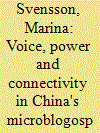|
|
|
Sort Order |
|
|
|
Items / Page
|
|
|
|
|
|
|
| Srl | Item |
| 1 |
ID:
185834


|
|
|
|
|
| Summary/Abstract |
Social media misinformation is widely recognized as a significant and growing global problem. Yet, little is known about how misinformation spreads across broader media ecosystems, particularly in areas with varying internet access and connectivity. Drawing on research in northern Ghana, we seek to address this gap. We argue that ‘pavement media’—the everyday communication of current affairs through discussions in marketplaces, places of worship, bars, and the like and through a range of non-conversational and visual practices such as songs, sermons, and graffiti—is a key link in a broader media ecosystem. Vibrant pavement and traditional media allow for information from social media to quickly cross into offline spaces, creating a distinction not of the connected and disconnected but of first-hand and indirect social media users. This paper sets out how social, traditional, and pavement media form a complex and deeply gendered and socio-economically stratified media ecosystem and investigates its implications for how citizens differentially encounter, process, and respond to misinformation. Based on the findings, we argue that efforts intended to combat the spread of misinformation need to move beyond the Western-centred conception of what constitutes media and take different local modalities of media access and fact-checking into account.
|
|
|
|
|
|
|
|
|
|
|
|
|
|
|
|
| 2 |
ID:
133729


|
|
|
|
|
| Publication |
2014.
|
| Summary/Abstract |
This article addresses the issue of who has a voice on microblogs in China and what having a voice in the age of social media actually means. In theory, microblogs have a low threshold and are easy to use, thus enabling more Chinese citizens to articulate their concerns as well as paving the way for interactivity among different groups of people. In reality, however, not all citizens are as likely to use microblogs or be heard through them. Although microblogging practices have spread from the technology-savvy early adopters to broader groups in society, one should not assume that microblogs have helped bridge the information gap among China's ICT users, or empowered everybody in equal measure. This article discusses the demographics of microblog users, addressing diffusion patterns, number and range of followers, as well as topics discussed and how these are shaped by microbloggers of different socio-economic status. It makes use of and synthesizes existing surveys and previous studies in the field, while also building on this author's qualitative and ethnographic research on journalists and migrant workers. The article also addresses the 2013 crackdown on opinion leaders on microblogs and its implications for public debates and connectivity on social media.
|
|
|
|
|
|
|
|
|
|
|
|
|
|
|
|
|
|
|
|
|